Splitting atoms together
DOI: 10.1063/PT.3.5197
Between the end of World War II and the start of the US Atoms for Peace program in late 1953, nuclear physics was largely a classified field. Fissile materials were tightly controlled by the US government. Eager to catch up on the new science of nuclear fission, European countries emerging from German occupation were stonewalled by their wartime ally. Despite those restrictions on knowledge and materials, Norway and the Netherlands managed to jointly construct a nuclear reactor by 1951. Called the Joint Establishment Experimental Pile (JEEP), the Dutch–Norwegian reactor was the first to be constructed by nonmajor powers. Why were the Dutch and Norwegians the first smaller countries to build a reactor, and how did they succeed so quickly?
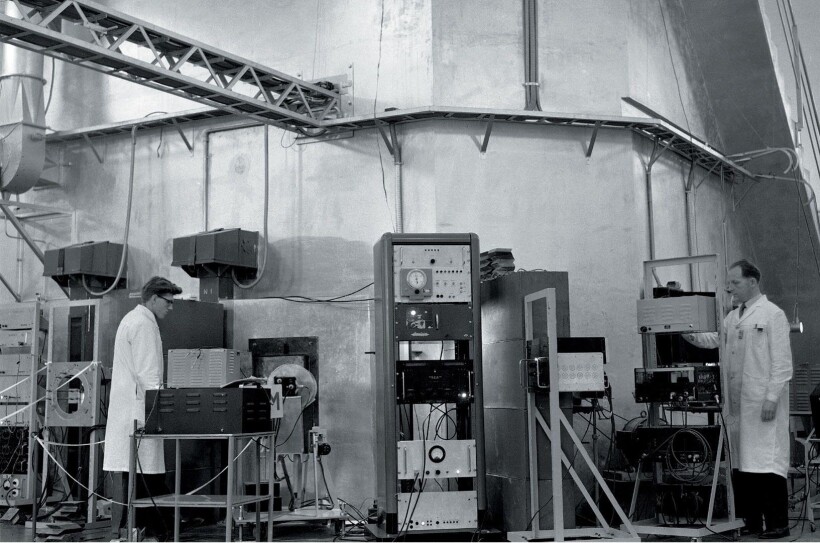
Scientists working at the Dutch–Norwegian nuclear reactor, the Joint Establishment Experimental Pile, sometime in the 1950s. (Photo from NTB/Alamy Stock Photo.)
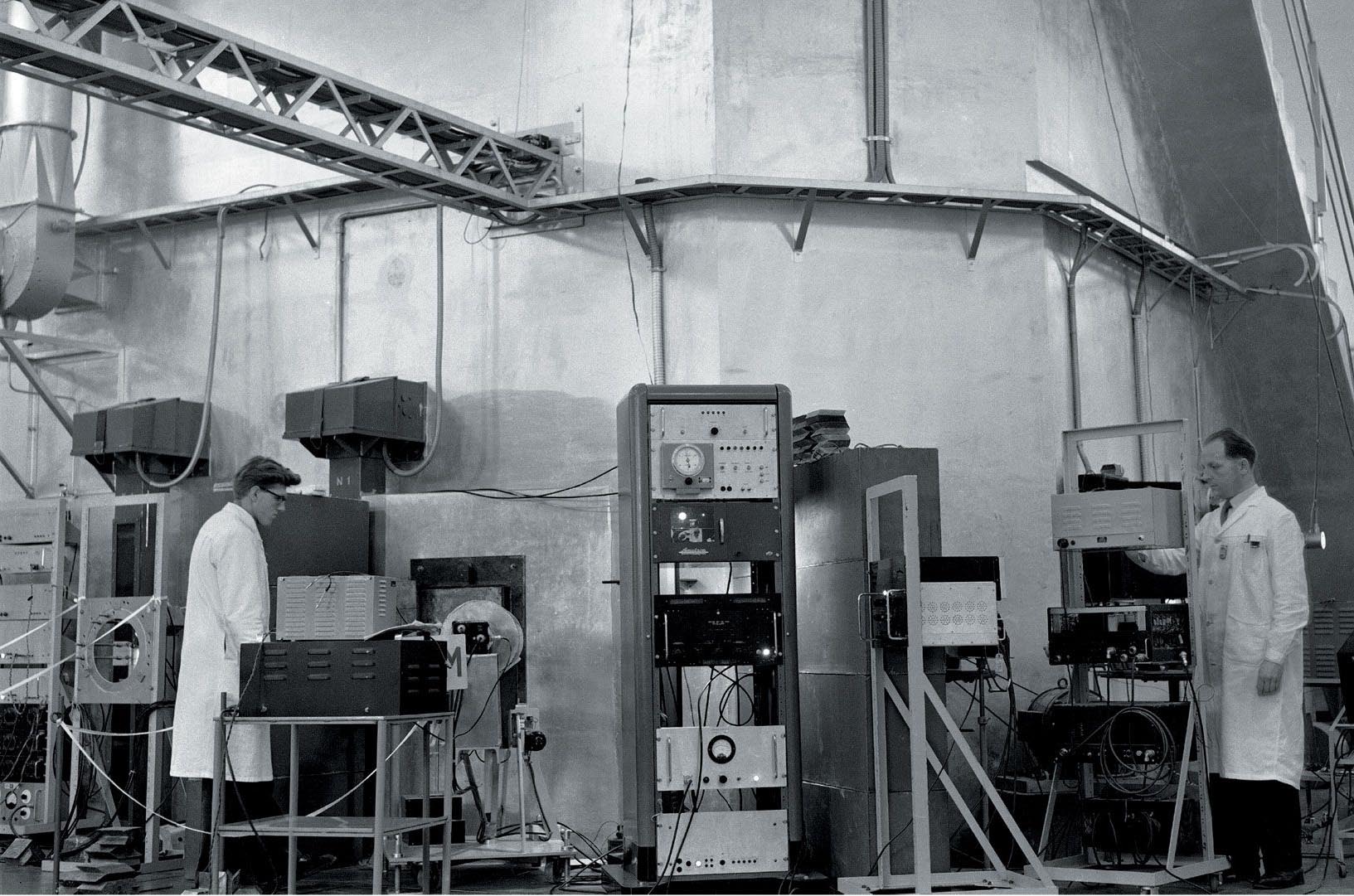
One major reason was because of the scientists who led the joint reactor project, Dutch physicist Hans Kramers (see
Hans Kramers
Hendrik Anthony “Hans” Kramers (1894–1952) began studying physics with Paul Ehrenfest at the Netherlands’ Leiden University, where he received his doctorate in 1919. Most of his doctoral work, however, was done with Niels Bohr in Copenhagen, and Kramers remained there after finishing his studies. During that time, he became one of the early pioneers of quantum mechanics. He returned to the Netherlands in 1926, when he was named professor of theoretical physics at the University of Utrecht. After Ehrenfest’s death in 1933, Kramers succeeded him as a professor of theoretical physics in Leiden.
After World War II, Kramers became the Dutch government’s main adviser on rebuilding physics and nuclear issues. In 1946 he served as chairman of the technical subcommittee to the United Nations Atomic Energy Commission. He then spent spring 1947 at the Institute for Advanced Study in Princeton, New Jersey. During that visit to the US, he also attended the Shelter Island Conference on the Foundations of Quantum Mechanics, where his discussion of mass renormalization probably inspired Hans Bethe to determine how to calculate the Lamb shift (see the article by Freeman Dyson, Physics Today, October 2005, page 48
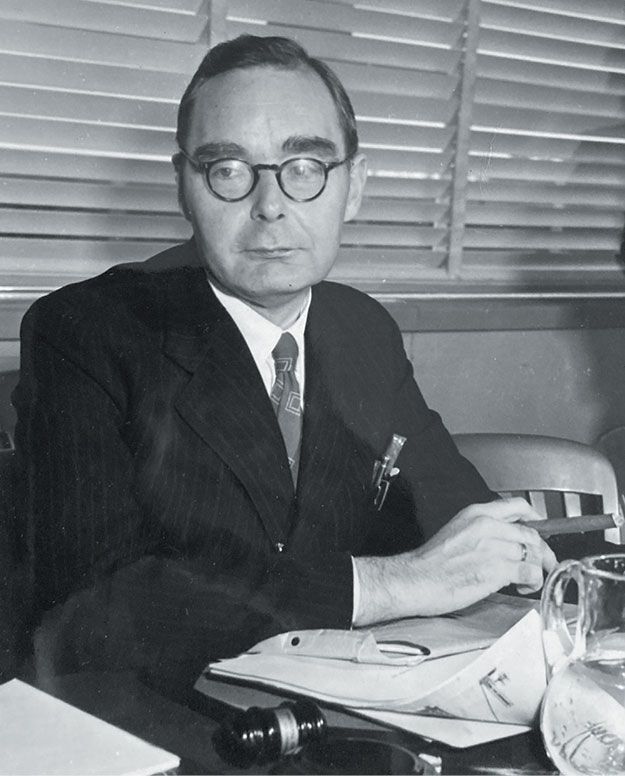
Hans Kramers pictured in 1946 in his capacity as chair of the technical subcommittee to the United Nations Atomic Energy Commission. (Courtesy of the Kramers family.)
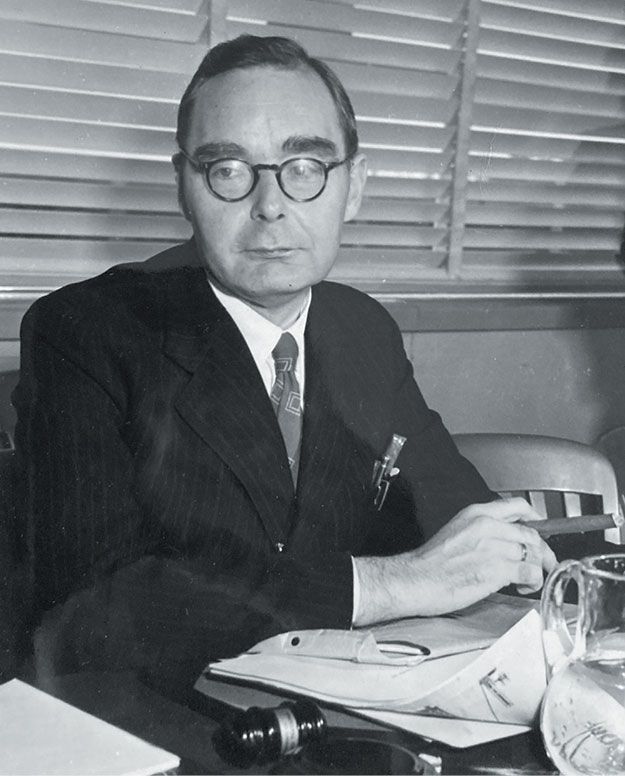
Gunnar Randers
Gunnar Randers (1914–92) studied astrophysics at the University of Oslo until 1937, when he became an assistant to the theoretical astrophysicist Svein Rosseland. He then traveled to the US, where he worked at the Mount Wilson Observatory from 1939 to 1940 and then at the University of Chicago’s Yerkes Observatory until 1942. His main contribution to physics dates from that period, when he introduced what is now known as Randers geometry in general relativity.
In Chicago, Randers became acquainted with Enrico Fermi and his team, who were building the world’s first nuclear reactor. A few months before the Chicago reactor went critical, Randers moved to the UK, where he joined Rosseland and other Norwegian scientists in assisting with the war effort. During that time, he worked under the UK nuclear physicist John Cockcroft, who was closely involved in constructing the UK’s first reactors and would be an important postwar contact.
In summer 1946 Randers traveled to the US with a gifted engineer, Odd Dahl, and collected valuable classified nuclear information that would eventually lead to the construction of a Dutch–Norwegian heavy-water reactor in 1951. Randers dominated Norwegian nuclear policy for several decades. He was instrumental, for example, in pushing through a sale of heavy water to Israel for its Dimona reactor in 1959 without public scrutiny. 12 He served as the personal adviser on nuclear affairs to United Nations secretary general Dag Hammerskjøld, and from 1968 to 1973, he was NATO’s assistant secretary general of scientific affairs. He died in February 1992.

Gunnar Randers (right) with Queen Juliana of the Netherlands (left) during a visit to the Dutch–Norwegian reactor in May 1953. (Courtesy of the Norwegian Museum of Science and Technology, CC BY-NC-SA 4.0
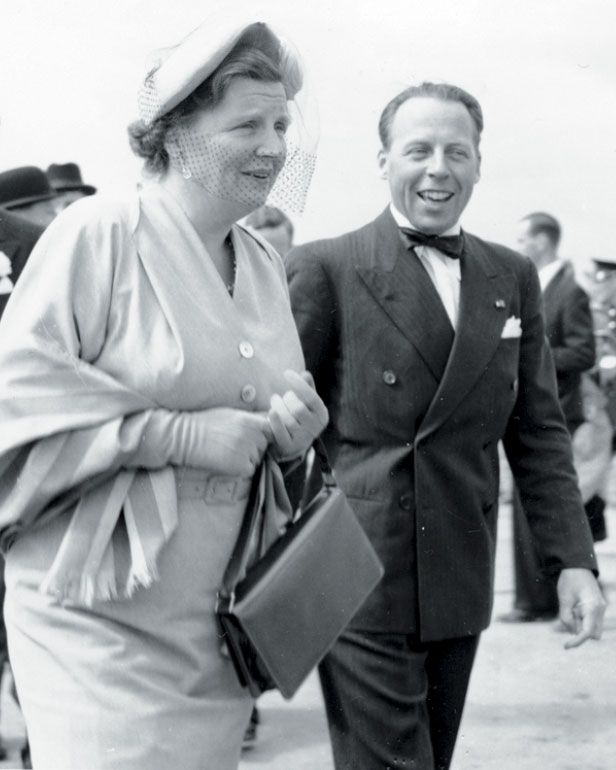
Another reason for the Dutch and Norwegians’ success was their access to two critical nuclear ingredients: uranium and heavy water. The Netherlands had acquired 10 tons of uranium just before the war, and Norway had its own heavy-water production facility. As was characteristic for the early postwar era in Europe, the Dutch and Norwegian governments left their scientists a relatively free hand with those materials. Kramers and Randers were able to take advantage of narrow but crucial windows of opportunity to make the technical and political advances necessary to realize the reactor project.
Dutch uranium
The discovery of nuclear fission by Otto Hahn, Lise Meitner, and Fritz Straßmann in December 1938 sparked feverish research efforts around the world. In Paris, for instance, Frédéric Joliot-Curie led an advanced research group on nuclear physics. Following closely behind was a team led by Enrico Fermi and Leo Szilard in New York (see the article by Spencer Weart, Physics Today, February 1976, page 23
News of the discovery reached the Netherlands that March, when Joliot-Curie informed the Dutch physicist Wander de Haas about his preliminary results. De Haas, one of the directors of the Kamerlingh Onnes Laboratory at Leiden University, quickly realized the strategic value of uranium and sprang into action. He used his close government contacts to persuade the Dutch prime minister, Hendrik Colijn, to immediately order a large amount of uranium from the Belgian firm Union Minière du Haut-Katanga, which mined deposits in the Belgian Congo.
The Dutch placed their uranium order just a few weeks before Joliot-Curie made Union Minière aware of uranium’s new potential. When 200 50-kilogram barrels of yellowcake—a form of uranium oxide—arrived at his laboratory in Leiden, De Haas initially had them stored in his laboratory. But the uranium increased radiation levels and interfered with measurements, so the barrels were moved to a locked room in a basement at the Delft University of Technology. Remarkably, they remained undisturbed in the basement during the war, undiscovered by the German occupiers.
Across the Atlantic Ocean, the US, with assistance from the UK and Canada, initiated the Manhattan Project in 1942, which culminated in the successful development of an atomic bomb three years later. The wartime allies simultaneously began attempting to gain control of strategic nuclear materials across the world. Starting in summer 1944, a team of UK and US scientists and diplomats set out to negotiate control over uranium and thorium ores. They were concerned about the latter because it could be used to breed fissile uranium-233, a potential bomb material.
On behalf of the Dutch government, Kramers and Dutch foreign minister Eelco van Kleffens negotiated a secret agreement with US and UK officials in late summer 1945 stating that export of thorium from the thorium-rich monazite sands in the Dutch East Indies (present-day Indonesia) would be subject to UK–US control. The agreement was signed in London on 4 August, two days before the bombing of the Japanese city of Hiroshima. On signing, the US ambassador in London, John Winant, confided to Van Kleffens that the UK wartime nuclear project “would receive considerable publicity within a few days.” 1
The bombings of Hiroshima and Nagasaki made European physicists realize how far behind they were. Kramers was named chair of a Dutch committee that began an extensive program of nuclear research. Even though he and the committee members rejected developing nuclear weapons, they decided to keep secret the knowledge of Dutch uranium stores. In 1946–47 Kramers spent considerable time in the US, where he was called on to assist Van Kleffens—now the Dutch ambassador to the US—with United Nations Security Council discussions concerning nuclear weapons and energy. Kramers was chair of the UN technical subcommittee that came to the unanimous conclusion that international control of nuclear weapons was possible. 2 But rising tensions between the USSR and the US forestalled such an agreement.
Kramers’s stay in the US also gave him the opportunity to reestablish contacts with friends in the physics community. He spent spring 1947 in Princeton, New Jersey, where he met regularly with Oppenheimer, who had just assumed the directorship of the Institute for Advanced Study. Kramers and Oppenheimer, who had known each other since the 1920s (see figure
Figure 1.
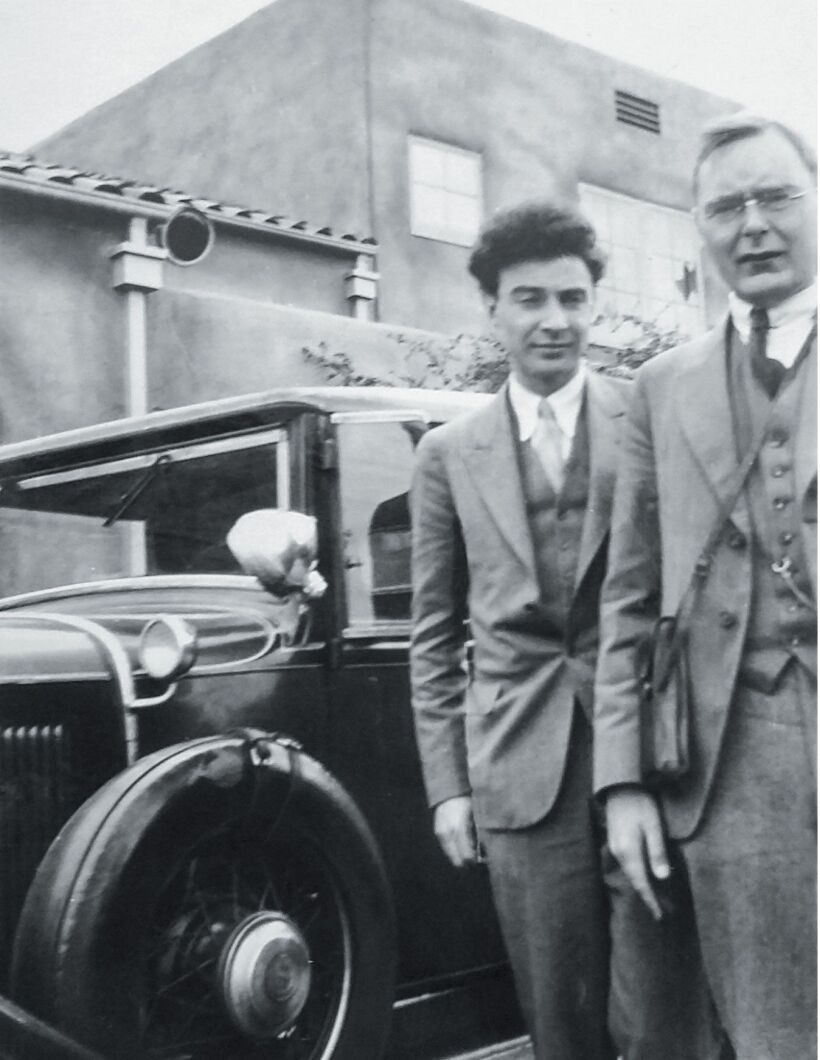
J. Robert Oppenheimer (left) and Hans Kramers (right) in the US, around 1930. (Courtesy of the Kramers family.)
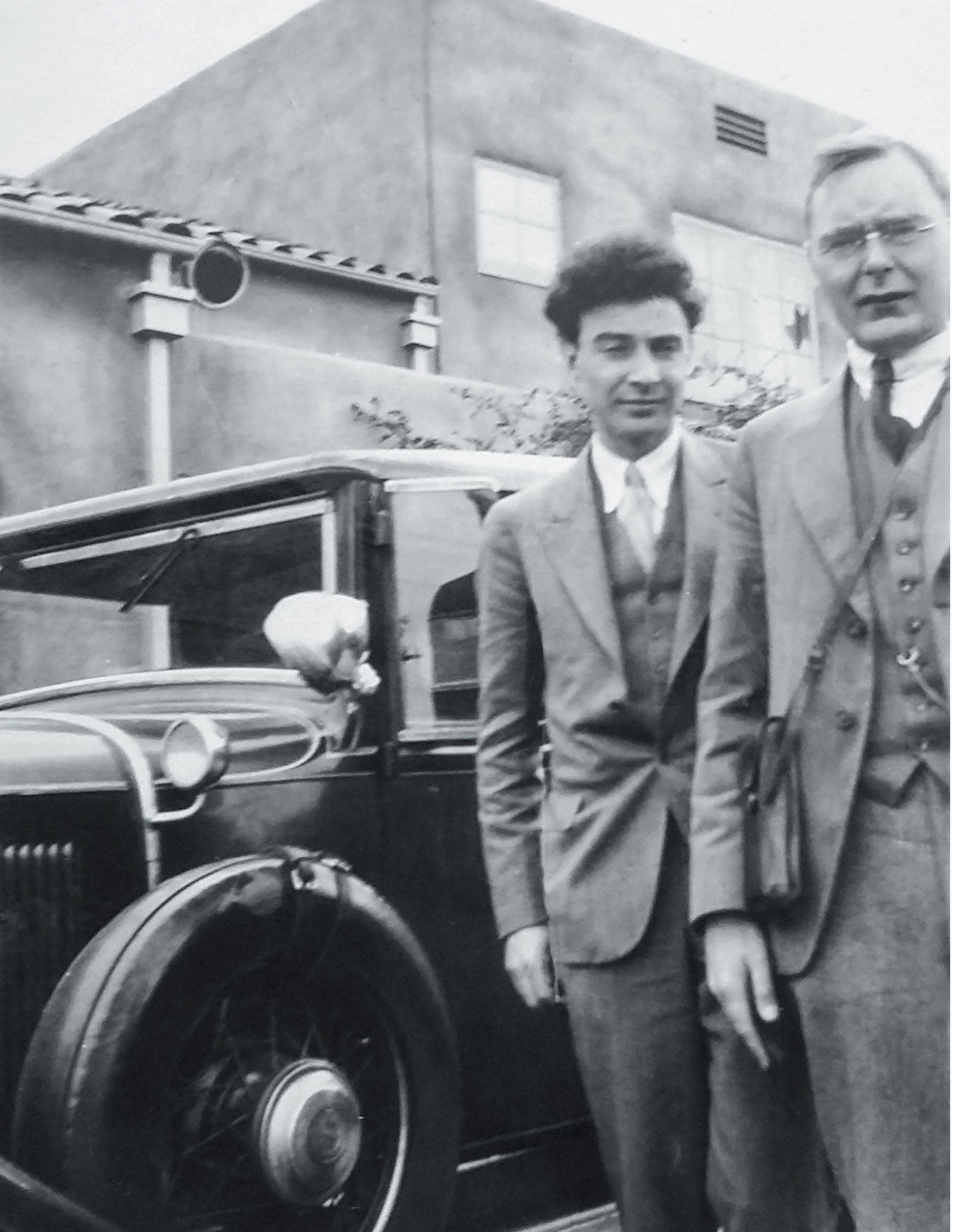
The Norwegian reactor
The genesis of Norway’s civilian nuclear program lay in its heavy water supply. Shortly after the discovery of deuterium in 1931, Norway began to produce heavy water on an industrial scale at a fertilizer plant operated by the company Norsk Hydro in the town of Rjukan. During World War II, the Allies and the Norwegian resistance famously sabotaged the plant to prevent the Germans from acquiring nuclear weapons. The Norwegians, however, quickly got it up and running again after the war ended. At the same time, Randers began perusing the Smyth Report—the semitechnical survey of the Manhattan Project, released by the US government in August 1945, that marked the limits of declassified nuclear knowledge. He realized the importance of Norway’s heavy water.
Randers had gone to the US in 1939 and worked in Chicago from 1940 to summer 1942. His office was in the same building as Fermi’s group, which finished constructing the world’s first nuclear reactor by the end of 1942. Informal exchanges with Fermi and his staff gave Randers a decent idea of what they were working on. Randers then moved to the UK to assist in the war effort. There he worked with John Cockcroft, the UK nuclear physicist and future Nobel Prize recipient.
While in the UK, Randers was shown the French patent for a heavy-water reactor, which helped inspire him to build a reactor in Norway. Frustrated yet stimulated by the incomplete information available in the Smyth Report, Randers set out to gather the materials and knowledge necessary to design a reactor. He felt it was crucial for the country to be involved in such a modern science project to “secure its existence in the long run.” 3
Together with the gifted engineer Odd Dahl, Randers traveled to the US in summer 1946, where he collected valuable information. During that time, most physicists who had been involved in the Manhattan Project generously provided information under the assumption that nuclear secrets would soon be declassified. In that spirit of budding transparency, Randers talked with old friends, including Fermi and Walter Zinn, with whom he discussed the construction of the world’s first heavy-water reactor, Chicago Pile-3. But the biggest coup from the trip was when Randers learned the average number of secondary neutrons, a piece of information that was only officially declassified in 1950.
The short window for open scientific exchange on nuclear physics soon closed when President Harry S. Truman signed the Atomic Energy Act on 1 August 1946. Also known as the McMahon Act, the law specified that US citizens could not share nuclear knowledge with foreign nationals. Violators could face the death penalty. But Randers and Dahl had already obtained the information they needed, which was that a Norwegian reactor would be feasible with only modest amounts of heavy water and uranium. 4
Back in Europe, Randers started cooperating with Joliot-Curie’s group in France, which was being supplied with heavy water by Norsk Hydro. During the war, most of the French scientists in the group had worked on a small heavy-water reactor in Canada, the Zero Energy Experimental Pile (ZEEP), which they now aimed to copy in France. Even though the French scientists had been required to pledge secrecy when they left Canada, Randers got easy access to the French nuclear program by playing the heavy-water card.
In exchange for heavy water, the French scientists also provided Randers and Dahl with reactor-design information and 50 tons of pure graphite for the neutron reflector. (In early heavy-water reactors, a layer of graphite was positioned on the outside of the reactor to reflect escaping neutrons back into the core and minimize the required quantities of uranium and heavy water.) Dahl started building the reactor at a site in the town of Kjeller, outside Oslo, while Randers desperately looked for a supply of uranium.
Randers first approached Cockcroft, who had headed the wartime ZEEP project in Canada and was now head of the UK nuclear effort, with an offer to trade Norwegian heavy water for uranium. Although Cockcroft wanted to help, he was stymied by the US’s uranium monopoly. Randers then considered continuing the collaboration with France. But that was unattractive because Joliot-Curie, who during the war had joined the Communist Party, wanted to serve in a leading capacity, and the Norwegian government did not want to offend the US at a time of early Cold War tensions. 5 Randers then looked into the uranium ore available in Norway, but it was too low grade to use.
By early 1950 the reactor was almost finished, although the prospects for a quick start looked bleak without the required uranium. But unexpected help was on the way. In the Netherlands, a group of small countries had just gathered to discuss possible nuclear initiatives. Norway, however, had been unable to attend. So Kramers then went to Norway looking for a partner to build a reactor. He brought with him a dowry of uranium, which was a godsend to the Norwegians. Kramers and Randers were struck by the sudden opportunity. On the spot, they decided to start a collaboration that would be formalized shortly thereafter. 6
Openness versus secrecy
To protect its nuclear monopoly, the US implemented strong secrecy measures to prevent nuclear information from spreading. In Europe, secrecy as a policy tool emerged more slowly, and scientists were generally trusted to deal with nuclear matters as they saw fit. Nevertheless, many European policymakers and physicists first sought to emulate the US. Kramers, for example, began working on a draft of a Dutch atomic energy act with Van Kleffens in 1948 that initially contained a secrecy clause.
But Kramers changed his mind after speaking with “a prominent American, ‘O.’”—almost certainly Oppenheimer—at the 1948 Solvay Conference on Physics in Brussels. Based on those discussions, Kramers reported to the Dutch government that the US secrecy policy had been a disaster. The restrictions on sharing nuclear knowledge, he wrote in a report, had led to “the direst consequences” and threatened to “end in Russia-like terror situations.” A “great struggle” was occurring behind closed doors, and Kramers suggested that US allies could aid proponents of atomic openness by opposing “extreme” US secrecy policies. 7
That argument successfully forestalled the inclusion of a formal secrecy arrangement in the Dutch law. The government’s willingness to forego secrecy policies may have also been because of the situation in the thorium-rich Dutch East Indies. After Indonesia gained its independence in 1949, the Netherlands lost access to the thorium ore, which meant it no longer needed legal secrecy measures. But the Dutch government also seemed to have had little desire to control its physicists. They were given a free hand—at least until tangible results were in sight.
But the Dutch and Norwegians still required UK and US consent. Earlier Norwegian requests for reactor assistance had been denied. Views on the control of nuclear knowledge and technology, however, started to shift after the Soviet nuclear test in 1949 and the revelation in early 1950 of Klaus Fuchs’s wartime nuclear espionage. The question for the Dutch and Norwegians was how to approach their more powerful allies: through trusted scientific contacts or at the government level?
Although the Dutch government preferred using scientific contacts, Oppenheimer dissuaded Kramers from sounding things out on a technical level. Knowing that the US government was beginning to exert more control over scientists than its European counterparts, Oppenheimer told Kramers to talk to US officials at the State Department and the Atomic Energy Commission (AEC). The Dutch ambassador to the US gave Kramers the same advice, which turned out to be valuable because the State Department saw itself as the first point of contact on nuclear matters. Moreover, it did not oppose the Dutch–Norwegian reactor plan.
Subsequent discussions with AEC scientists in June 1950 went smoothly. Although the AEC wasn’t willing to assist the Dutch and Norwegians, it did not oppose what it termed their “modest developments” in nuclear energy. 8 In a letter to Cockcroft, Kramers informed the UK about their plans. After some discussion, the Dutch and Norwegians agreed to keep the UK government informed, with Cockcroft serving as the intermediary. The political obstacles were cleared, which meant that only the technical hurdles remained. Foremost among them was purifying uranium yellowcake and using the resulting ore to produce nuclear fuel.
That was not a trivial matter. The US State Department had discouraged the Dutch and Norwegians from seeking further assistance from France, which left the UK as the best option for help. So Kramers began discussing fuel elements with Cockcroft. Randers’s initial idea had been to copy the French reactor design and use sintered uranium oxide as fuel, but he didn’t have access to US data on its heat conductivity, which was classified. Efforts to extract that information from US colleagues also failed.
So Cockcroft and Kramers had to calculate the value themselves. But they made an error regarding the conductivity of uranium oxide, which resulted in their projected value for the heat conductivity being far too low. The value implied that at the reactor’s intended power output of more than 100 kilowatts, the heat buildup in the center of the sintered blocks would destroy them. So Cockcroft and Kramers incorrectly concluded that oxide would not work. It was precisely the kind of mistake Oppenheimer had warned against in a March 1950 lecture: “We know that in secrecy error, undetected, will flourish and subvert.” 9
The Dutch and UK governments eventually decided to exchange the Dutch yellowcake for UK uranium metal. Cockcroft offered Kramers and Randers uranium rods that wouldn’t work in the UK’s larger plutonium production installations but were good enough for the small Dutch–Norwegian reactor. The rods were modified slightly so that they could be placed together in pairs, and they fit in the existing design (see figure
Figure 2.
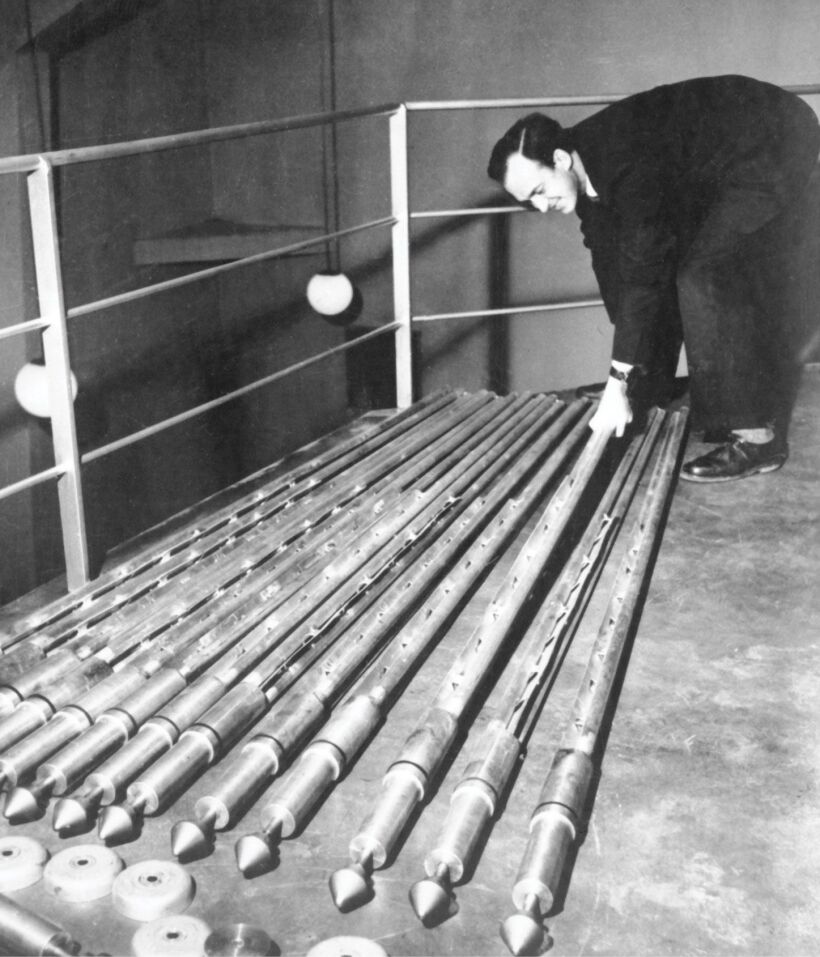
Rods of uranium fuel for the Joint Establishment Experimental Pile reactor, pictured in 1951. (Courtesy of the Norwegian Museum of Science and Technology, CC BY-SA 4.0
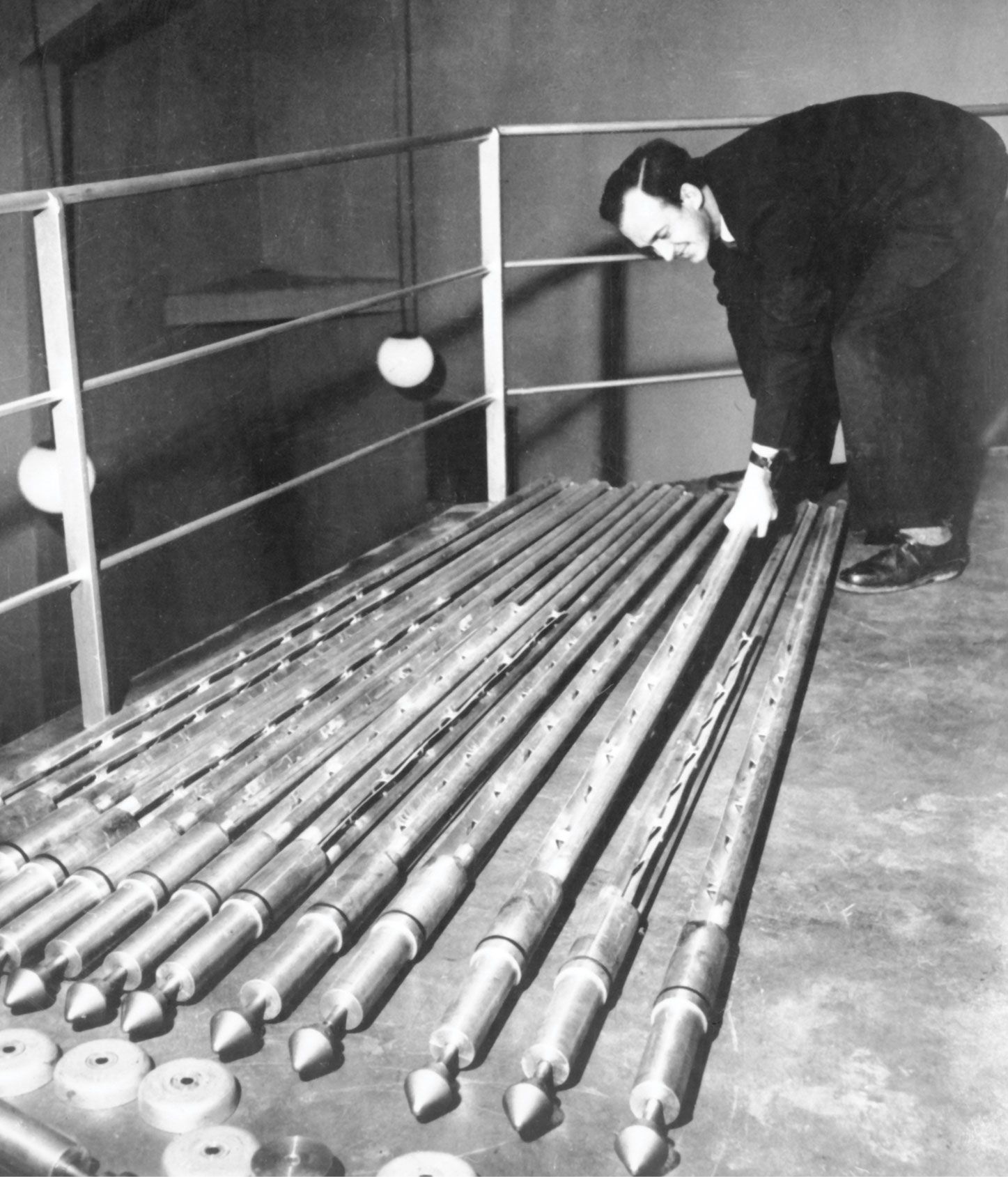
Internationalism and legacy
Analogous to its Canadian predecessor ZEEP, the Dutch–Norwegian reactor was called the Joint Establishment Experimental Pile (JEEP). It was the first open, international research reactor. A US physicist, A. W. McReynolds, was among the early visitors, and he reported on his experience at Kjeller in an April 1955 Physics Today article (page 13
That same internationalism was displayed at the Kjeller Conference on Heavy Water Reactors in August 1953, one of the first international meetings on nuclear physics. It was attended by representatives from 18 countries, including Argentina, India, Israel, and what was then Yugoslavia. Many of those representatives would go on to play central roles in their countries’ nuclear programs.
One of the Yugoslav scientists at the conference, Dragoslav Popović (see figure
Figure 3.

Foreign scientists in front of the Dutch–Norwegian Joint Establishment Experimental Pile reactor. In the middle, with bowtie, is the Yugoslav physicist Dragoslav Popović. The US physicist A. W. McReynolds is second from right. (Courtesy of BetaText.)
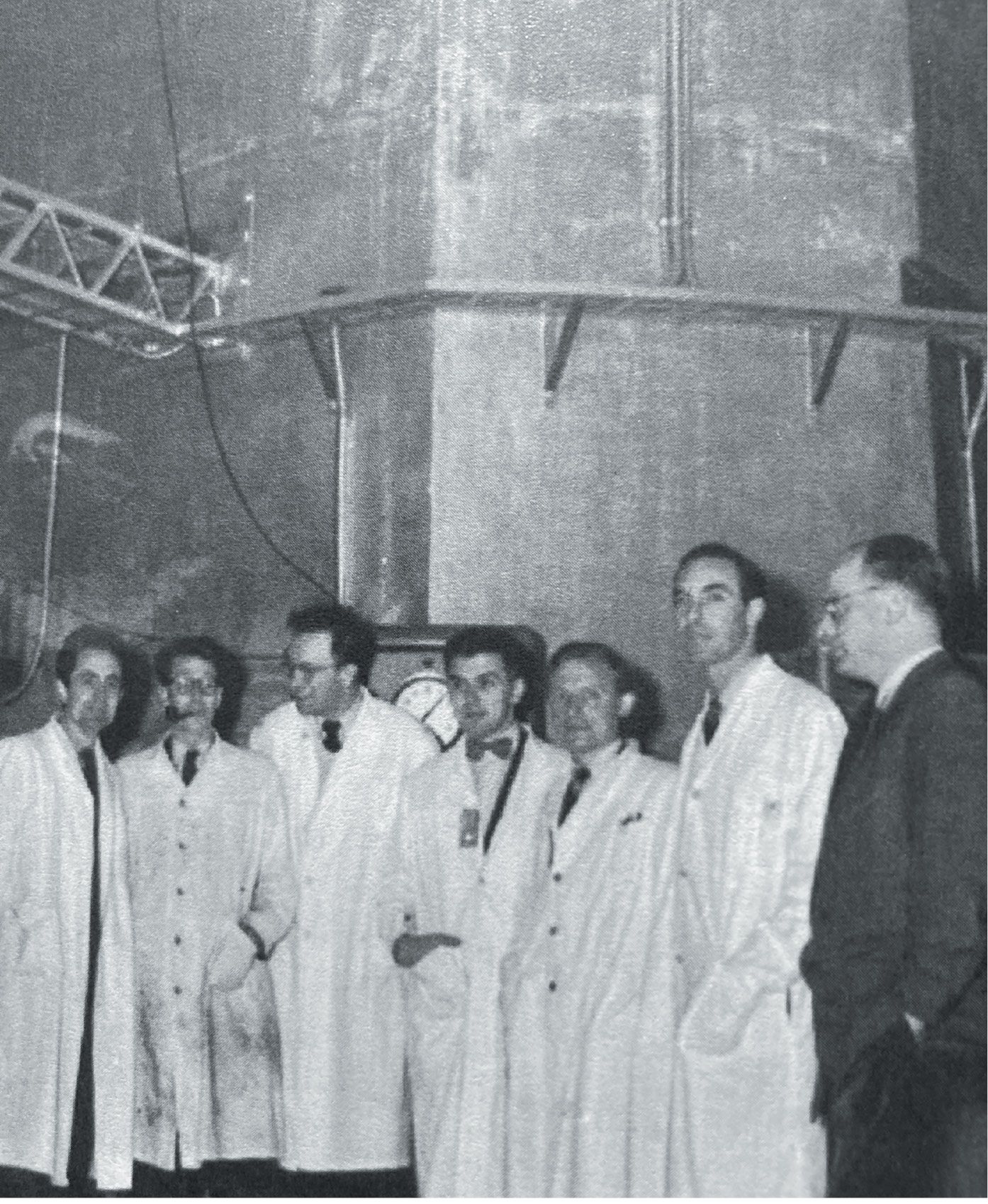
Although Atoms for Peace was a blessing for many countries with nuclear aspirations, it augured the end of the Dutch–Norwegian collaboration. By selling reactors complete with fuel, the US regained some control over the burgeoning nuclear reactor programs of its allies. The Netherlands bought a research reactor with enriched fuel from the US, which served its own interests but not Norway’s. As a result, Norway built its own new heavy-water reactor in Halden, on the Swedish border. It became operational in 1958.
Because Norway possessed a significant amount of hydroelectric power, it was initially interested in using nuclear power—namely, special heavy-water reactors—for naval propulsion. In the Netherlands, on the other hand, research into nuclear power and isotope production was high on the agenda. As a result, the joint research program slowly disintegrated during the late 1950s. But JEEP remained important as a training and teaching instrument. The Dutch–Norwegian reactor school was founded there in 1958. JEEP began to suffer from technical problems by 1960, so Norway built a successor, JEEP II, which became operational in 1967. The original JEEP was retired, and its reactor vessel was buried. It was dug up in 1993 amid concerns about nuclear waste originating from the early reactor program (see figure
Figure 4.
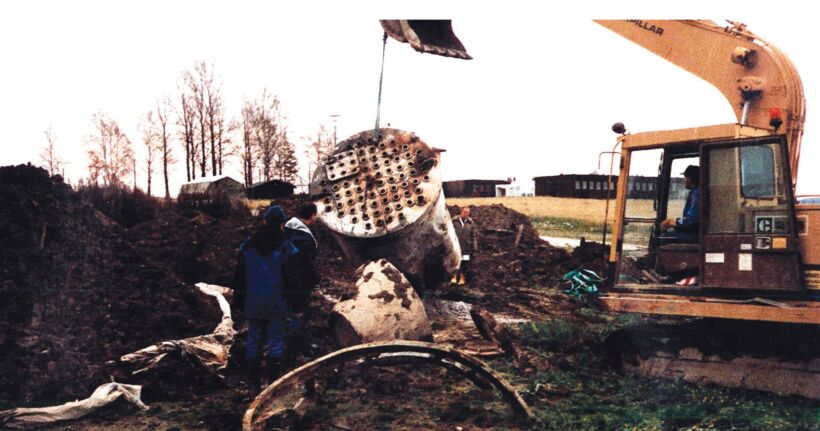
The reactor vessel of the Joint Establishment Experimental Pile was dug up in 1993 amid fears of contamination at the Kjeller site. (Courtesy of IFE.)
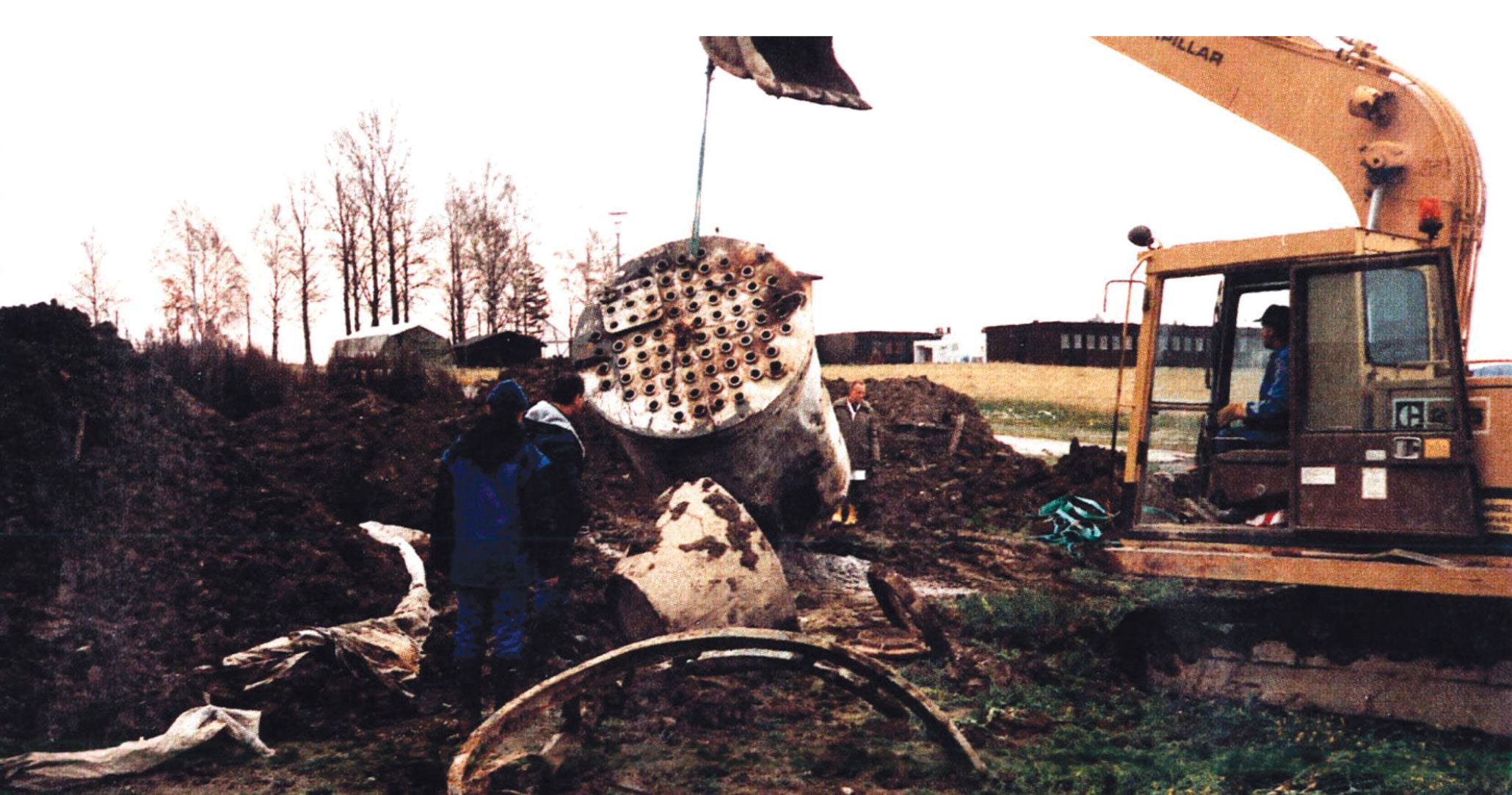
But the physical remnants of the reactor do not define JEEP’s legacy. It was the first open research reactor in the world, and it successfully challenged the postwar US standard of secrecy and control. It helped both Norway and the Netherlands develop early nuclear programs and train a pool of young scientists. Furthermore, scientists from many other countries began their nuclear careers in Kjeller, which was often the first step in their own countries’ nuclear programs, most of which were peaceful.
JEEP was a symbol of postwar progress, national pride, and scientific self-confidence. It fostered an early form of nuclear internationalism that foreshadowed global collaborations like Atoms for Peace. It also taught the international community an early lesson about the control of nuclear technology. Without early access to heavy water and uranium, Norway and the Netherlands never could have built JEEP as early as they did. The control of strategic materials remains the bedrock of international nonproliferation efforts today.
References
1. J. M. van Splunter, Int. Hist. Rev. 17, 485 (1995), p. 494. https://doi.org/10.1080/07075332.1995.9640718
2. R. G. Hewlett, O. E. Anderson Jr, Volume 1, A History of the United States Atomic Energy Commission: The New World1939/1946, Pennsylvania State U. Press (1962), p. 594.
3. G. Randers, Bull. At. Sci. 6, 142 (1950). https://doi.org/10.1080/00963402.1950.11461242
4. G. Randers, Lysår (Light years), Gyldendal Norsk Forlag (1975).
5. B. Goldschmidt, The Atomic Complex: A Worldwide Political History of Nuclear Energy, American Nuclear Society (1982), p. 250.
6. J. M. van Splunter, Love at First Sight: Co-operation Between the Netherlands and Norway on the Peaceful Use of Atomic Energy, 1950–1960, IFS Info no. 2, Norwegian Institute for Defence Studies (1994), p. 7.
7. H. A. Kramers, report (15 August 1948), inventory no. 13099, Ministry of Foreign Affairs: Code archive 1945–1954, access no. 2.05.117, National Archives of the Netherlands, The Hague.
8. J. M. van Splunter, Kernsplijting en diplomatie: De Nederlandse politiek ten aanzien van de vreedzame toepassing van kernenergie, 1939–1957 (Nuclear fission and diplomacy: Dutch policy regarding the peaceful application of nuclear energy), Het Spinhuis (1993), p. 127.
9. J. R. Oppenheimer, Bull. At. Sci. 7, 6 (1951), p. 8. https://doi.org/10.1080/00963402.1951.11457126
10. M. Kleemans, Hist. Stud. Nat. Sci. 51, 48 (2021). https://doi.org/10.1525/hsns.2021.51.1.48
11. D. Popović, N. Rajšić, J. Nucl. Energy 1, 170 (1954). https://doi.org/10.1016/0891-3919(54)90009-1
12. A. Forland, Nonprolif. Rev. 4(2), 1 (1997), p. 10. https://doi.org/10.1080/10736709708436661
More about the Authors
Machiel Kleemans is a research fellow at the Vossius Center for the History of Humanities and Sciences at the University of Amsterdam. Hans Wilschut is a professor emeritus of physics at the Van Swinderen Institute for Particle Physics and Gravity at the University of Groningen in the Netherlands.


